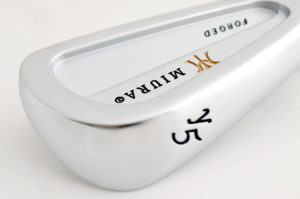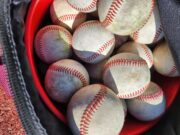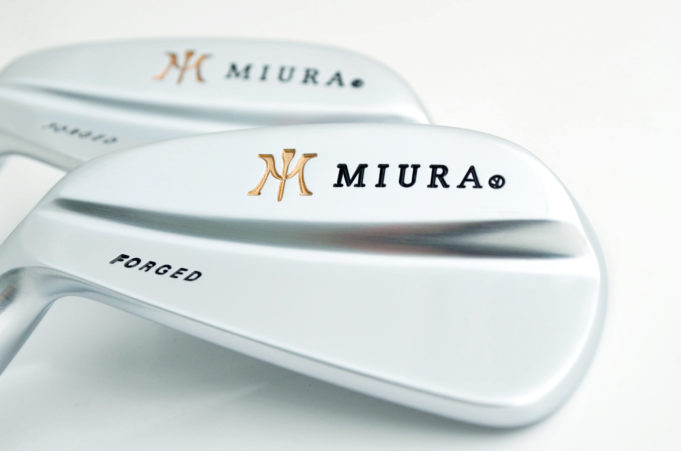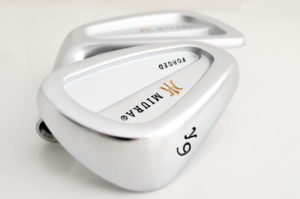Golfers as a group can be somewhat shallow. If something looks good on the surface, we are ready to open up the wallet and break out the credit card. This behavior is especially evident when it comes to our clubs.
Sure, the ad might say it can add ten to 15 yards to your drive, correct a hook or slice, sink all sorts of putts or allow you to make the Phil Mickelson flop shot from greenside. All that is secondary to so many golfers. That stick needs to look good when you put it behind the ball. If it doesn’t, chances are very good it will go back on the rack and never darken your golf bag.
I was tasked with the job of test driving the latest clubs from Katsuhiro Miura who has been crafting clubs since 1957. This latest product was the Miura Y grind irons for left handers. Yeah. Tough gig.
Essentially the Y grind is the leading edge being beveled off so there isn’t a sharp, digging edge.
“For those who take pelt divots it’s excellent as it makes the divot a lot shallower,” according to Rick McKenzie at Alberta Golf Works in Red Deer.

He and his son Jordy received the parts , built the clubs, five iron to pitching wedge, fitted them to my swing and off I went to test them on some unsuspecting subjects.
Now of course I took them for a test drive first and was won over from the very first ball struck. I still get all gushy when I think of the feeling I get when the ball leaves the club. It was difficult to let other southpaws swing these clubs but I did source out more test volunteers.
I had players of varying levels of ability take part in my less than scientific kind of testing and each of the five players, who ranged from a zero handicap to about a 25, all had similar comments when seeing the club for the first time.
“This club looks great.” “I really like the top line of the club.” “Slick look.” “Very nice.” There was one comment which can’t be printed but needless to say he was impressed with it and added a whistle at the end of his colourful remark. My expert on club building was also taken by the looks.
“I like the clean lines it gives you. It’s not big rounded edges or square toe box. Everything about it, it just looks like it’s streamlined down there,” said Rick, who has seen plenty.
You get the picture. It was love at first sight. Pretty good result as far as first date introductions go. But we need to dig a little deeper to get to the heart of the matter.
It was time to explore how the club feels because once again, if it doesn’t feel right many of us will not hit a ball with it. Instead, we just waggle it around, make some faux swings and then give it a last look before placing it back with its brothers and sisters.
My guinea pigs said the club felt so much lighter than what they were using with one player saying it was close to the same weight. I can mark that down as a passing grade.
On the more technical side of this equation McKenzie says he has never worked with a product with more tolerance in terms of the weight, the loft and the lie they should be.
[
 quote_box_center]“A lot of sets we buy we have to adjust the weight from a three iron to a pitching wedge by as much as ten grams in some of the heads,” he said. “Whereas these, we’ve never had a weight near these golf clubs to make them match each other.” This certainly speaks to the craftsmanship which goes into a Miura club.[/quote_box_center]
quote_box_center]“A lot of sets we buy we have to adjust the weight from a three iron to a pitching wedge by as much as ten grams in some of the heads,” he said. “Whereas these, we’ve never had a weight near these golf clubs to make them match each other.” This certainly speaks to the craftsmanship which goes into a Miura club.[/quote_box_center]
Getting past the honeymoon stage of looks and feel, golfers still need to be sure the club will hit the ball better than what they are using now. It’s like buying a new vehicle. It looks good in the lot and feels comfy when you sit in it but what happens when you hit the gas?
All of my test subjects were able to hit essentially solid shots with the clubs at some point. Most of them used a five, six, seven or eight iron on the range and results varied for each. One player remarked the misses seemed to be a lot less with the Miura clubs than his current set. He was smiling when he said that by the way. Happy about a miss? That has to mean something.
One high handicapper had a tough time getting the ball airborne at first but when he was advised (by a friend) to stop swinging like he was bringing down a redwood he managed to hit quite a few dead straight with some nice height and distance. He was impressed to say the least. I had to make sure I got the club back.
Distances did vary with my subjects but the majority, including me, felt there were a few more yards gained with each club in comparison to their own clubs.
The common thread was how the ball felt when it left the club. “Like butter” was the phrase being uttered the most after each shot.
From a club makers perspective McKenzie says Miura are easy clubs to make because they are so well balanced.
“We do our work and then once we’re done putting them together we fit them for lofts and lies and take away all your excuses. When you hit bad shots, now you look in the mirror.”
The end result of this experiment was a general consensus that while looks are everything for most golfers, this club has plenty of style but brings a lot of function to the party.
I think this is going to be a long and healthy relationship.
To learn more about Miura go to miuragolf.com.








































